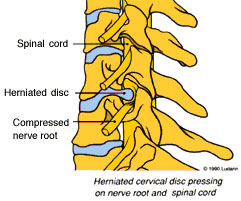|
:::
 |
 |
 |
 |

|
Anterior Cervical Discectomy |
 |
What is it? |
|
Anterior cervical discectomy is an operation performed on the upper spine to relieve pressure on one or more nerve roots, or on the spinal cord. The procedure is explained by the words anterior (front), cervical (neck), and discectomy (cutting out the disc).
|
 |
Why is it done? |
|
 When a disc ruptures in the cervical spine, it puts pressure on one or more nerve roots (often called nerve root compression) or on the spinal cord, as seen in (Figure 2). This pressure causes symptoms in the neck, arms, and even legs. Further pressure may be caused by rough edges of bone, called bone spurs, that naturally build up around some herniated discs. When a disc ruptures in the cervical spine, it puts pressure on one or more nerve roots (often called nerve root compression) or on the spinal cord, as seen in (Figure 2). This pressure causes symptoms in the neck, arms, and even legs. Further pressure may be caused by rough edges of bone, called bone spurs, that naturally build up around some herniated discs.
|
 |
The Operation |
|
In this operation, the cervical spine is reached through a small incision in the front of your neck. After the soft tissues of the neck are separated, the intervertebral disc and bone spurs are removed. The space left between the vertebrae may be left open or filled with a small piece of bone. In time the vertebrae may fuse, or join together.
If used, the pre-formed bone graft may be obtained from a bone bank. It will not be rejected by your body, because it is avascular (contains no blood cells). In some circumstances, or if your surgeon prefers, the bone graft might instead be removed from your own hip through a second incision. |
 |
What happens afterwards? |
|
Successful recovery from anterior cervical discectomy requires that you approach the operation and recovery with confidence based on a thorough understanding of each process. Your surgeon has the training and expertise to correct physical defects by performing the operation; he and the rest of the health care team will support your body's efforts to heal its damaged tissues. Full recovery will also depend on you having a strong, positive attitude, setting small, realistic goals for improvement, and working steadily to accomplish each goal.
|
|
 |
|
 |
|